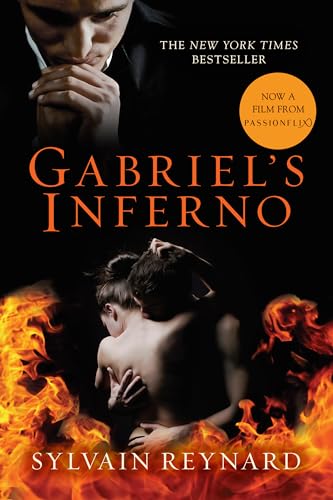If you have ever wondered what happens when a brooding professor meets a shy, book-loving student, you are in for a treat. In this review, I talk about all the juicy, slow-burn parts of ‘Gabriel’s Inferno’—the romance, the classic lit references, and a fair bit of angst. I even brought my book club pals along for the ride, which means you get the harsh truth along with the swooning. So, grab a snack and settle in, because this is not your grandma’s romance novel (unless your grandma is very hip).
In a nutsheel
Gabriel’s Inferno is a romantic drama by Sylvain Reynard. This book is all about brooding professors, shy students, and the art of flirting through Italian poetry. If you love steamy stories with a big scoop of tension, this one might just tickle your fancy.
The book falls squarely in the romance genre, but it’s not just smooches and longing looks. Reynard packs in themes of redemption, forgiveness, and the messiness of trust. There’s a good splash of classic literature stuff thrown in too, which honestly made me feel smarter every time I caught a reference. The story also explores emotional healing and second chances, so get ready for some deep feelings along with the drama.
Romantic Tension: Sparks, Stumbles, and Sighs in Gabriel’s Inferno
Let me tell you, the romantic tension between Gabriel and Julia in Gabriel’s Inferno is so thick you could slice it with a butter knife. Seriously, it’s like being at a dinner party with two people who are secretly in love but keep pretending they’re just “friends.” And as a guy who once tried (and failed) to hide a crush on a college classmate, I got major déjà vu from these two. The way Gabriel and Julia dance around their feelings is pure slow-burn drama. If you enjoy love stories that take their sweet time, you’ll eat this up like leftover cake at midnight.
Of course, sometimes I wanted to shout at the book: “Just say how you feel already!” These two are the masters of longing looks, awkward pauses, and almost-confessions. At times, all the build-up can feel a bit exhausting. But that’s exactly what makes their rare moments of honesty so rewarding. When Gabriel lets his guard down for even half a paragraph, it’s like the sun breaking through after a week of rain. Julia, meanwhile, is so shy and earnest that you can’t help rooting for her, even if her hesitancy sometimes drags things out.
I have to admit, some readers might roll their eyes at the constant misunderstandings and brooding, but if you like your romance angsty and dramatic, this book brings it. Think longing stares across a crowded lecture hall—and multiply it by ten. Trust me, it’s a wild ride.
Next up, I’ll chat about how classic literature references in Gabriel’s Inferno add extra flavor, like grated parmesan on your spaghetti!
Classic Literature References in Gabriel’s Inferno: A Bookworm’s Playground
One thing that made me grin while reading Gabriel’s Inferno was its sneaky use of classic literature. I felt a bit like a teacher’s pet for catching all those Dante spots! Sylvain Reynard, the author, is clearly a fan of old books. And he is not shy about bringing them into the story. You’ll see professors quoting Dante’s Divine Comedy, quoting poetry, and dropping names like Beatrice like it’s hot potato. In fact, the whole romance between Gabriel and Julia takes notes straight from classic epics. Where some books shout “contemporary,” this one mumbles “well-read” under its breath and winks at you knowingly.
But here’s where I tripped over my own bookmark. Not everyone loves references as much as I do. My friend Mike, who can’t spell ‘Shakespeare,’ kept asking me, “Steve, who is Virgil? Is he from Star Trek?” Sometimes, the story leans hard into the classroom setting, which is fun if you like feeling smart, but might be slow if you just want the spicy romance. Still, when done right, it adds a whole layer of meaning. Plus, it made me look up a few poems, which is more than most romance novels ever get me to do.
So, if you’re looking for a book that winks at book nerds and gives you homework (the fun kind), Gabriel’s Inferno knows its way around the library. But if you skipped English class, you can still enjoy the banter—even if you miss a Latin pun or two.
Next up, let’s see if the pace in this book is as speedy as Gabriel’s mood swings or more like waiting for a kettle to boil…
Pacing and Story Development in Gabriel’s Inferno: A Slow Burn Romance (Literally!)
Let me just say, Gabriel’s Inferno does not win any races for speed. If you’re the type who likes their love stories at full sprint, you might want to bring some snacks. This book knows how to take its sweet, agonizing time. I felt like I was watching two statues flirt for the first hundred pages. It’s not bad, though—once you settle in, the slow pacing actually helps you soak up the tension and makes the eventual pay-off feel earned. Still, a few times, I found myself yelling “Just kiss already!” at the pages, which my cat did not appreciate.
What Sylvain Reynard really nails (besides causing me to lose sleep) is the thoughtful story development. It’s clear every interaction, no matter how small, is there for a reason. From emails to accidental touches in hallways, the book piles up little moments that eventually snowball into big feelings. Sometimes it’s charming; sometimes, it feels like reading about two people trying to build Ikea furniture with oven mitts. Even the side stories—like Gabriel’s tragic past and Julia’s personal struggles—unfold with just enough mystery to keep you flipping pages. But fair warning: if you hate cliffhangers, prepare yourself. This book likes to tease.
So, if you prefer your stories to simmer before they boil, Gabriel’s Inferno serves you just right. Anyway, enough about pacing—let’s see if the characters have more layers than a lasagna in the next section about character depth and emotional growth!
Exploring Character Depth and Emotional Growth in Gabriel’s Inferno
If you ask me, the best stories are the ones where folks change for the better (or at least, try to). In Gabriel’s Inferno, the author puts both main characters, Gabriel and Julia, through an emotional boot camp. They don’t just fall in love and ride off into the Rome sunset. No, sir. Gabriel starts as a real grumpy-pants with enough baggage to sink a cruise ship. But, as the pages turn, he slowly takes responsibility for his past and tries not to act like a total jerkface.
Julia, on the other hand, doesn’t just exist to prop up Mr. Moody Professor. She wrestles with real insecurities, past traumas, and trust issues. I could relate to her hesitations—reminded me of that time I tried online dating and nearly ghosted myself. Both Gabriel and Julia grow and learn, even if sometimes you want to shake them and yell, “Just talk to each other!”
I have to give credit where it’s due: the emotional growth feels slow but real. The author actually makes you see (and sometimes squirm at) the ways people mess up, forgive, and try again. I found myself rooting for both of them even when they were being stubborn as goats.
In the end, would I recommend Gabriel’s Inferno for those looking for characters with depth and change? Absolutely. If you enjoy seeing folks wrestle with their feelings and come out stronger (eventually), this is your jam. Just be ready for lots of feelings along the way!
Conclusion
Well, that wraps up my review of Gabriel’s Inferno. This book was a bit of a rollercoaster. It has slow pacing, but I found the romantic tension and emotional growth between Gabriel and Julia worth sticking around for. The classic literature touches were like little Easter eggs for folks who dig that stuff (I felt fancy being in on the references). On the downside, things can drag if you don’t like lots of longing looks or pages of deep thoughts. But if you want a romance with some brains and depth, this one is a solid pick. Just don’t expect wild plot twists every five pages. Anyway, thanks for sticking with my review, and I hope I saved you from buying a bookshelf’s worth of tissues. Now, who’s up for a re-read of Dante?


